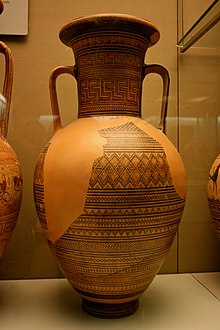
An amphora is a type of container with a pointed bottom and characteristic shape and size which fit tightly against each other in storage rooms and packages, tied together with rope and delivered by land or sea. The size and shape have been determined from at least as early as the Neolithic Period. Amphorae were used in vast numbers for the transport and storage of various products, both liquid and dry, but mostly for wine. They are most often ceramic, but examples in metals and other materials have been found. Versions of the amphorae were one of many shapes used in Ancient Greek vase painting.

Pottery, due to its relative durability, comprises a large part of the archaeological record of ancient Greece, and since there is so much of it, it has exerted a disproportionately large influence on our understanding of Greek society. The shards of pots discarded or buried in the 1st millennium BC are still the best guide available to understand the customary life and mind of the ancient Greeks. There were several vessels produced locally for everyday and kitchen use, yet finer pottery from regions such as Attica was imported by other civilizations throughout the Mediterranean, such as the Etruscans in Italy. There were a multitude of specific regional varieties, such as the South Italian ancient Greek pottery.

Black-figure pottery painting is one of the styles of painting on antique Greek vases. It was especially common between the 7th and 5th centuries BC, although there are specimens dating in the 2nd century BC. Stylistically it can be distinguished from the preceding orientalizing period and the subsequent red-figure pottery style.

Exekias was an ancient Greek vase painter and potter who was active in Athens between roughly 545 BC and 530 BC. Exekias worked mainly in the black-figure technique, which involved the painting of scenes using a clay slip that fired to black, with details created through incision. Exekias is regarded by art historians as an artistic visionary whose masterful use of incision and psychologically sensitive compositions mark him as one of the greatest of all Attic vase painters. The Andokides painter and the Lysippides Painter are thought to have been students of Exekias.
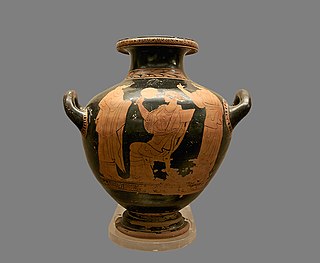
The hydria is a form of Greek pottery from between the late Geometric period and the Hellenistic period. The etymology of the word hydria was first noted when it was stamped on a hydria itself, its direct translation meaning 'jug'.
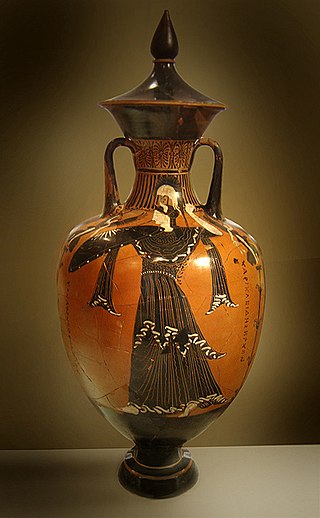
Panathenaic amphorae were the amphorae, large ceramic vessels, that contained the olive oil given as a prize in the Panathenaic Games. Some were ten imperial gallons and 60–70 cm (24–28 in) high. This oil came from the sacred grove of Athena at Akademia. The amphorae which held it had the distinctive form of tight handles, narrow neck and feet, and they were decorated with consistent symbols, in a standard form using the black figure technique, and continued to be so, long after the black figure style had fallen out of fashion. Some Panathenaic amphorae depicted Athena Promachos, goddess of war, advancing between columns brandishing a spear and wearing the aegis, and next to her the inscription τῶν Ἀθήνηθεν ἄθλων "(one) of the prizes from Athens". On the back of the vase was a representation of the event for which it was an award. Sometimes roosters are depicted perched on top of the columns. The significance of the roosters remains a mystery. Later amphorae also had that year's archon's name written on it making finds of those vases archaeologically important.
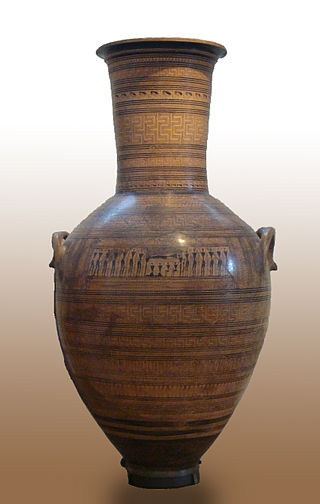
Geometric art is a phase of Greek art, characterized largely by geometric motifs in vase painting, that flourished towards the end of the Greek Dark Ages and a little later, c. 900–700 BC. Its center was in Athens, and from there the style spread among the trading cities of the Aegean. The so-called Greek Dark Ages were considered to last from c. 1100 to 800 BC and include the phases from the Protogeometric period to the Middle Geometric I period, which Knodell (2021) calls Prehistoric Iron Age. The vases had various uses or purposes within Greek society, including, but not limited to, funerary vases and symposium vases.

The Dipylon Master was an ancient Greek vase painter who was active from around 760–750 BC. He worked in Athens, where he and his workshop produced large funerary vessels for those interred in the Dipylon Gate cemetery, whence his name comes. His work belongs to the very late stage of the Geometric Style. His vases served as grave markers and libation receptacles for aristocratic graves and as such are decorated with a depiction of the prothesis scene representing the mourning of the deceased. Almost 50 vases have been attributed to the Dipylon Master and his workshop. Examples include the Dipylon Amphora in National Archaeological Museum, Athens, and the Elgin Amphora in the British Museum.

The Amasis Painter was an ancient Greek vase painter who worked in the black-figure technique. He owes his name to the signature of the potter Amasis, who signed twelve works painted by the same hand. At the time of the exhibition, "The Amasis Painter and His World" (1985), 132 vases had been attributed to this artist.

The Pan Painter was an ancient Greek vase-painter of the Attic red-figure style, probably active c. 480 to 450 BC. John Beazley attributed over 150 vases to his hand in 1912:
Cunning composition; rapid motion; quick deft draughtsmanship; strong and peculiar stylisation; a deliberate archaism, retaining old forms, but refining, refreshing, and galvanizing them; nothing noble or majestic, but grace, humour, vivacity, originality, and dramatic force: these are the qualities which mark the Boston krater, and which characterize the anonymous artist who, for the sake of convenience, may be called the 'master of the Boston Pan-vase', or, more briefly, 'the Pan-master'.

The Lysippides Painter was an Attic vase painter in the black-figure style. He was active around 530 to 510 BC. His conventional name comes from a kalos inscription on a vase in the British Museum attributed to him; his real name is not known.

Melian Pithamphorae or Melian Amphorae are names for a type of large belly-handled amphorae, which were produced in the Archaic period in the Cyclades. On account of their shape and painted decoration in the Orientalising style, they are among the most famous Greek vases. The amphorae are dated to the seventh and early sixth centuries BC; the last of them was made in the 580s. They were used as grave markers with the same function as the later grave statues and reliefs and were dedicated as cult objects in sanctuaries. With the increasing importance of sculpture in these roles, the production of these vases came to an end.

Ancient Greek art stands out among that of other ancient cultures for its development of naturalistic but idealized depictions of the human body, in which largely nude male figures were generally the focus of innovation. The rate of stylistic development between about 750 and 300 BC was remarkable by ancient standards, and in surviving works is best seen in sculpture. There were important innovations in painting, which have to be essentially reconstructed due to the lack of original survivals of quality, other than the distinct field of painted pottery.

The Burgon vase is the earliest known Panathenaic amphora, dating to around 560 BC, and the name vase for the ancient Greek painter of the Burgon Group. Today it is on display in the British Museum. The 61 cm high vase is short and squat, with a very low mouth and short neck. The handles are close to the body and small. The foot is tiny in proportion to the vase. The amphora was uncovered in 1813 in Athens and is named after Thomas Burgon (1787–1858), a merchant of the Levant Company, who brought it to England and sold it to the museum. It was discovered full of bone fragments, having been used as a funerary urn. The back side of the vase was seriously damaged by a pick-axe during the excavation.
The conservation and restoration of ancient Greek pottery is a sub-section of the broader topic of conservation and restoration of ceramic objects. Ancient Greek pottery is one of the most commonly found types of artifacts from the ancient Greek world. The information learned from vase paintings forms the foundation of modern knowledge of ancient Greek art and culture. Most ancient Greek pottery is terracotta, a type of earthenware ceramic, dating from the 11th century BCE through the 1st century CE. The objects are usually excavated from archaeological sites in broken pieces, or shards, and then reassembled. Some have been discovered intact in tombs. Professional conservator-restorers, often in collaboration with curators and conservation scientists, undertake the conservation-restoration of ancient Greek pottery.
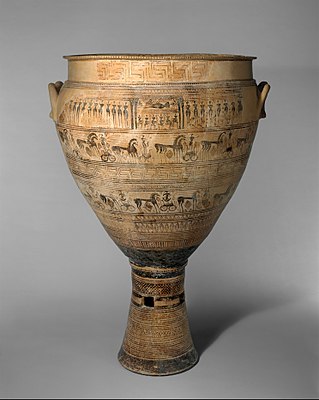
Dipylon Kraters are Geometric period Greek terracotta funerary vases found at the Dipylon cemetery; near the Dipylon Gate, in Kerameikos. Kerameikos is known as the ancient potters quarter on the northwest side of the ancient city of Athens and translates to "the city of clay." A krater is a large Ancient Greek painted vase used to mix wine and water, but the large kraters at the Dipylon cemetery served as grave markers.

The Euphiletos Painter Panathenaic Amphora is a black-figure terracotta amphora from the Archaic Period depicting a running race, now in the Metropolitan Museum of Art in New York. It was painted by the Euphiletos Painter as a victory prize for the Panathenaic Games in Athens in 530 BC.
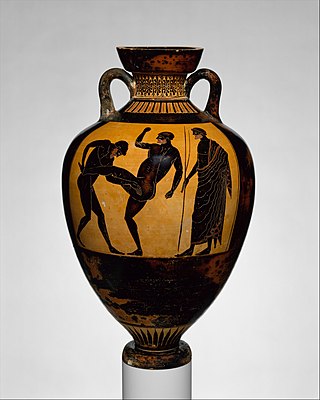
The Kleophrades Panathenaic prize amphora is an Archaic period amphora by the Kleophrades Painter from the collection of the Metropolitan Museum of Art. Dating to c. 500 BCE, the amphora, filled with olive oil, was the prize for a victor in the Panathenaia games in Athens. This particular amphora is a neck amphora that stands at 63.5 centimetres (25.0 in) tall.

Ancient Greek funerary vases are decorative grave markers made in ancient Greece that were designed to resemble liquid-holding vessels. These decorated vases were placed on grave sites as a mark of elite status. There are many types of funerary vases, such as amphorae, kraters, oinochoe, and kylix cups, among others. One famous example is the Dipylon amphora. Every-day vases were often not painted, but wealthy Greeks could afford luxuriously painted ones. Funerary vases on male graves might have themes of military prowess, or athletics. However, allusions to death in Greek tragedies was a popular motif. Famous centers of vase styles include Corinth, Lakonia, Ionia, South Italy, and Athens.
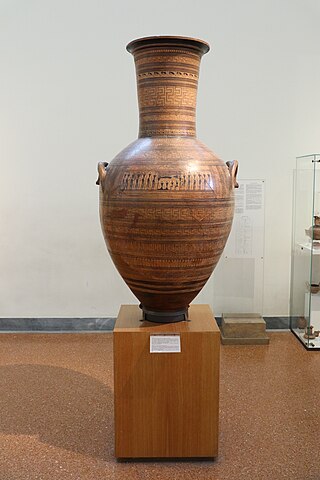
The Dipylon Amphora is a large Ancient Greek painted vase, made around 760–750 BC, and is now held by the National Archaeological Museum, Athens. Discovered at the Dipylon cemetery, this stylistic vessel belonging to the Geometric period is credited to an unknown artist: the Dipylon Master. The amphora is covered entirely in ornamental and geometric patterns, as well as human figures and animal-filled motifs. It is also structurally precise, being that it is as tall as it is wide. These decorations use up every inch of space, and are painted on using the black-figure technique to create the silhouetted shapes. Inspiration for the Greek vase derived not only from its intended purpose as a funerary vessel, but also from artistic remnants of Mycenaean civilization prior to its collapse around 1100 BC. The Dipylon Amphora signifies the passing of an aristocratic woman, who is illustrated along with the procession of her funeral consisting of mourning family and friends situated along the belly of the vase. The woman's nobility and status is further emphasized by the plethora of detail and characterized animals, all which remain in bands circling the neck and belly of the amphora.
